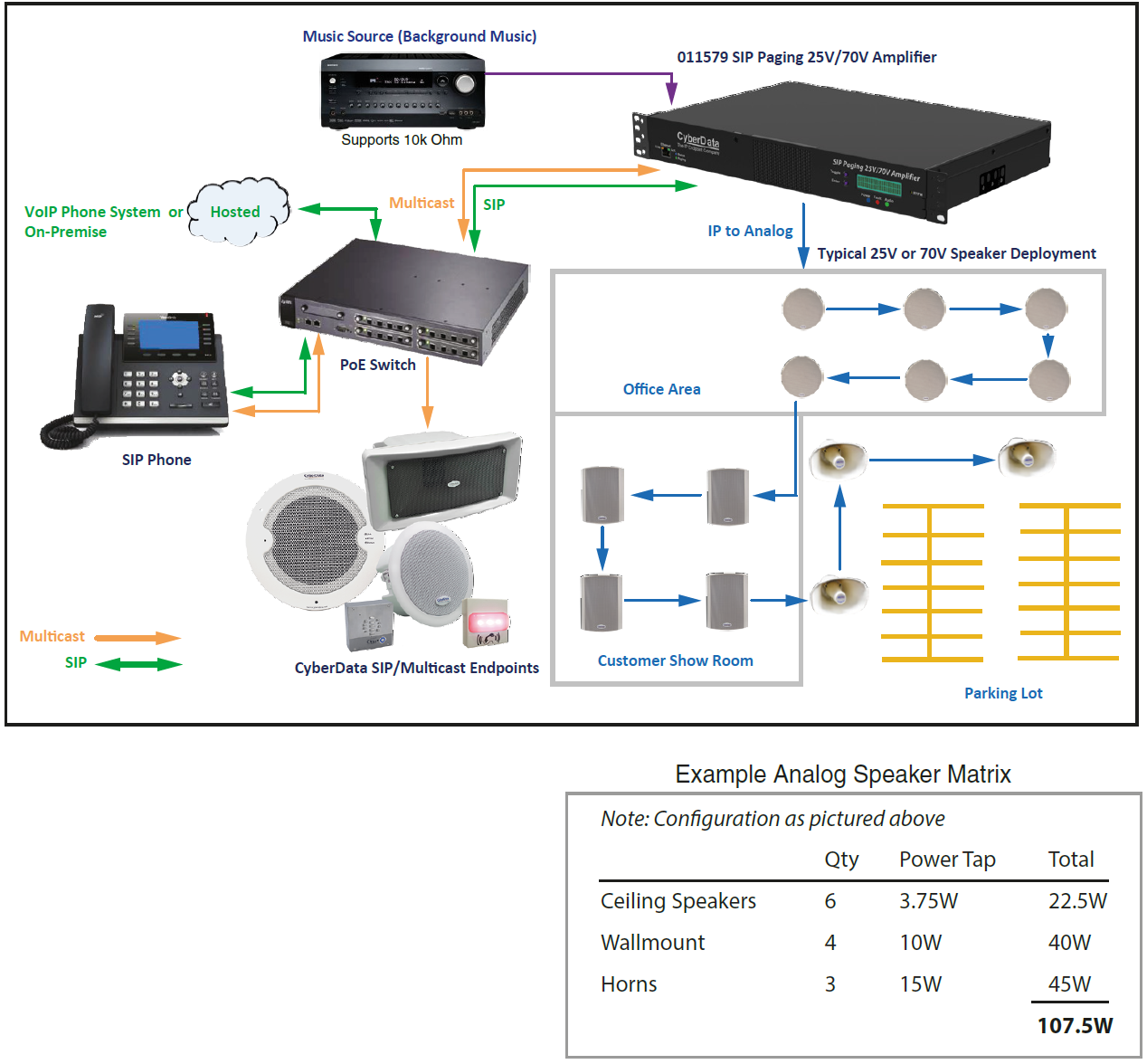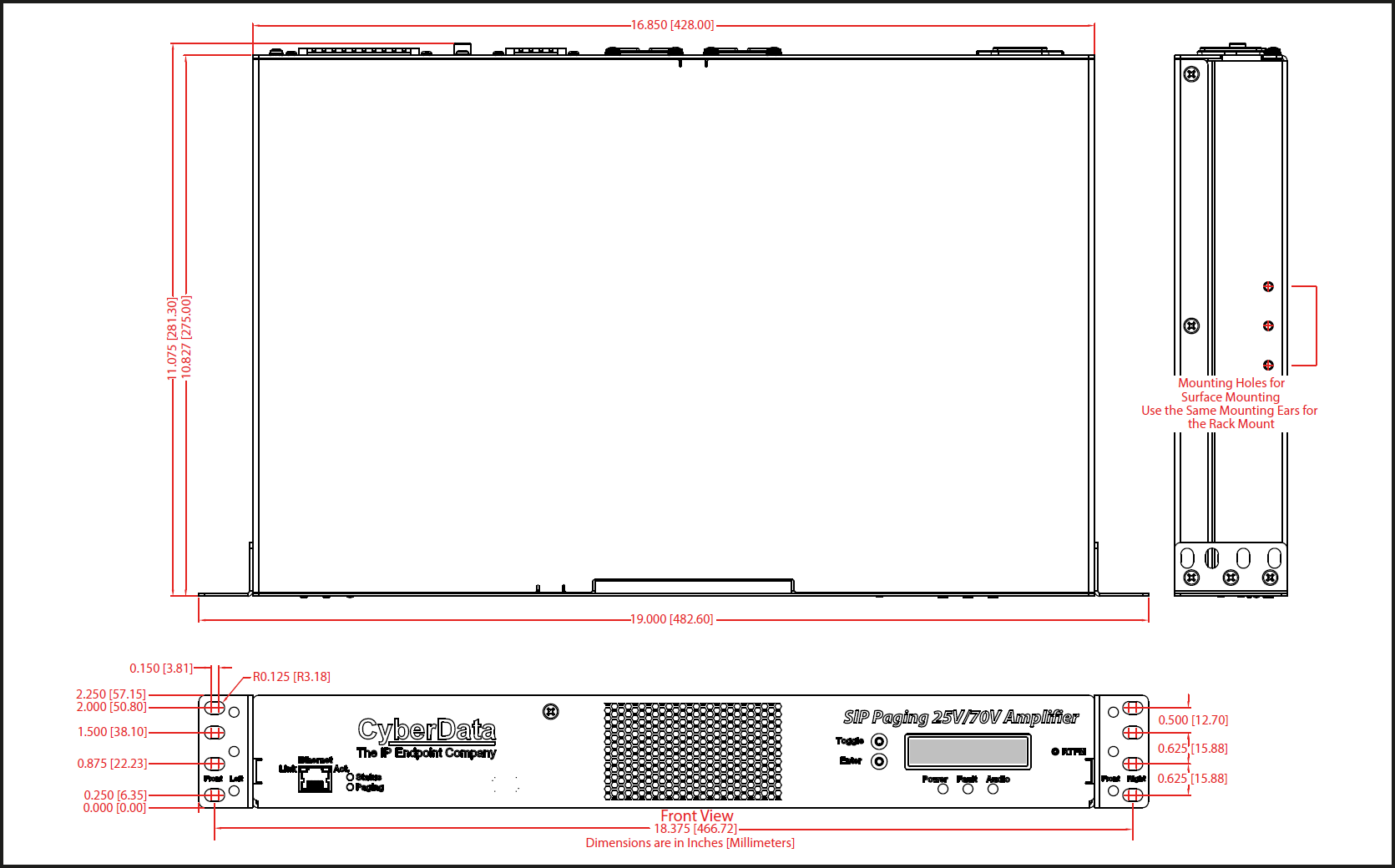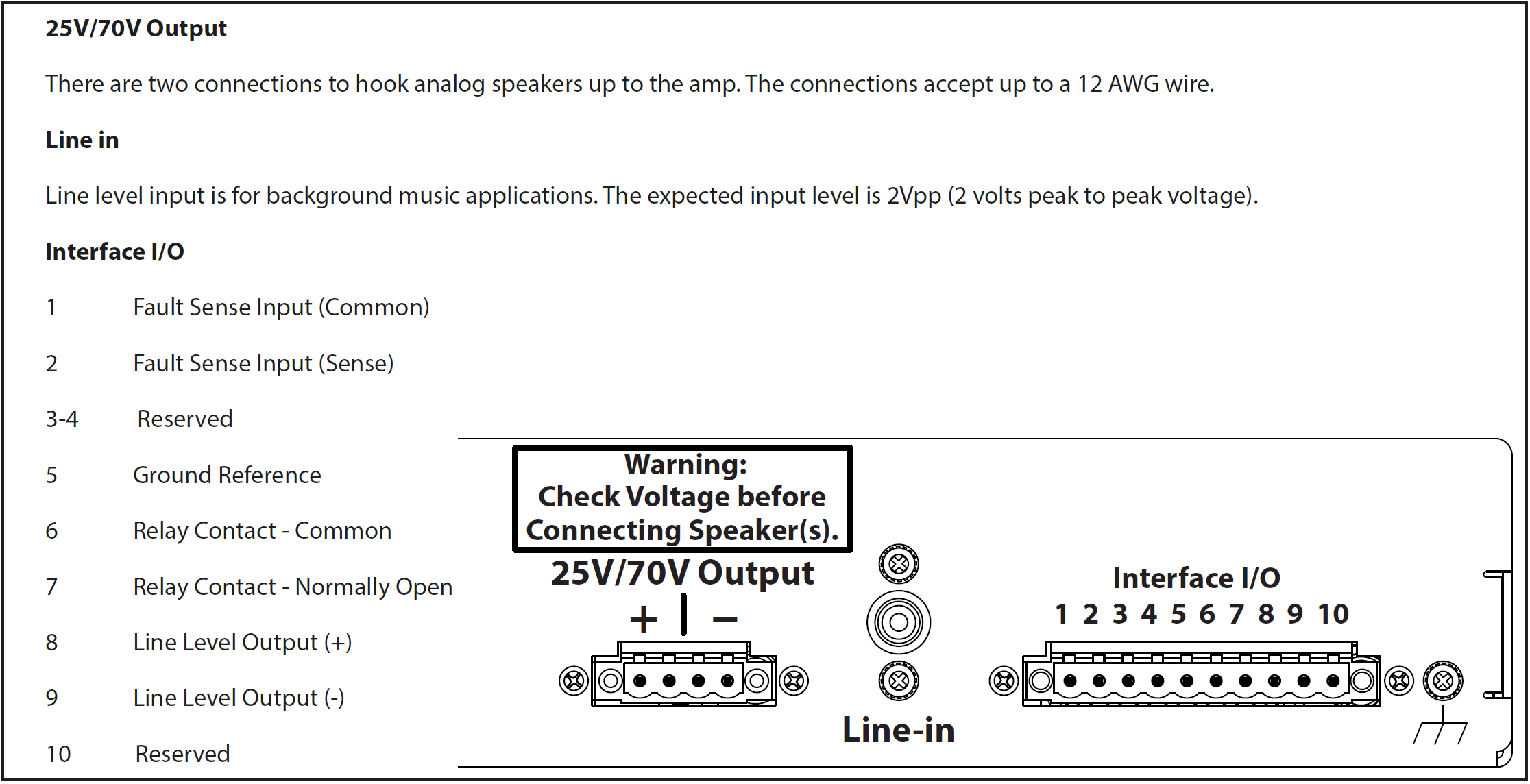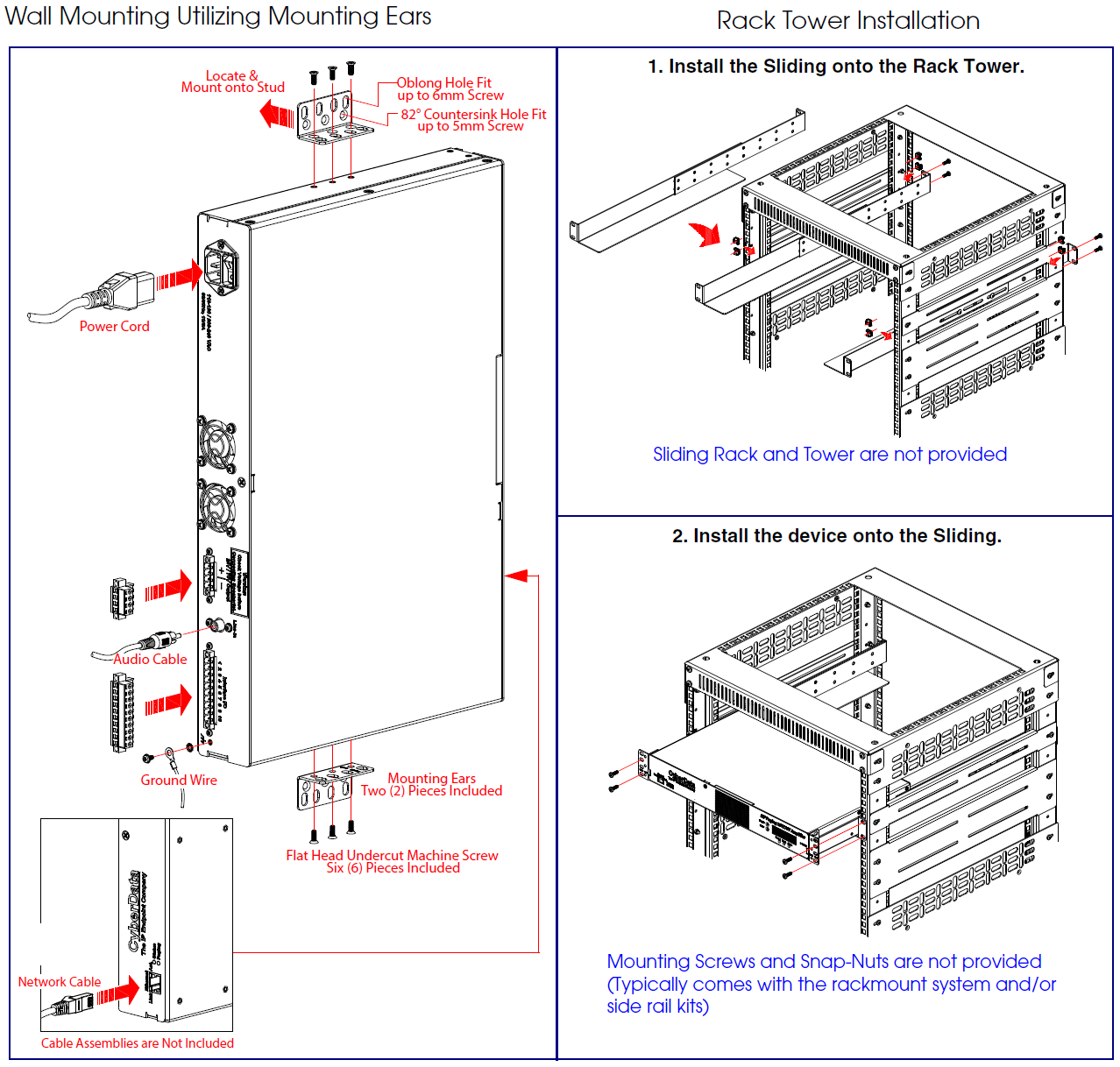Description
The SIP Paging 25V/70V Amplifier is an analog/IP hybrid, cost-effective paging solution. It allows customers to use CyberData's or their existing 70V, 25V, constant voltage speakers, and/or CyberData multicast endpoints in a VoIP environment.
The SIP Paging 25V/70V Amplifier sends and receives multicast, including from any channel of Poly phones.
The SIP Paging 25V/70V Amplifier has a built-in calendar-based scheduler that enables scheduled bells and prerecorded messages to be sent to different multicast zones as well as to a single analog zone. Multiple analog zones can be supported by adding additional SIP Paging 25V/70V Amplifiers.
CyberData's SIP enabled VoIP products are compatible with a vast majority of VoIP systems including SBCs, Gateways, and phone systems both on-premise or cloud-based.
Features
- Supports one analog zone with hundreds* of 25V or 70V speakers/horns with a single home run cable to the Amplifier.
- Calendar based bell scheduler
- Support for security code to prevent unwanted paging access
- Supports 100 DTMF controlled paging groups, that can transmit audio via multicast and the single analog channel
- Can page to unlimited endpoints that are enabled to receive multicast or Poly pages on any Poly channel
- Can receive pages directly from Poly phones as well as other devices that can send standard multicast
- Supports call-in stored message recording
- Paging prioritization
- Loud/Night Ringer function - second SIP extension
- Supports delayed pages, i.e. call buffering
- Supports multiple user accounts
- Master analog volume adjustment via web interface or front panel LCD controls
- Fault sense input
- Line-in for background music
- NTP-based internal clock with battery back-up
- LCD display for monitoring device status, configuration and diagnostics
- Configurable alerts for amplifier temperature threshold, protection, and recovery modes.
- 19-inch rack mountable with removable rack ears
- TLS 1.2 and SRTP enhanced security for IP Endpoints in a local or cloud-based environment
- HTTPS web based configuration
- Support for Cisco SRST resiliency
- Autoprovisioning via HTTPS, HTTP or TFTP
- Configurable event generation for device health and status monitoring
- 802.11q VLAN tagging
* Number of speakers supported will depend on the tap setting and the baseline voltage in your typical configuration.
Continuous power output is up to 392W when in 70V mode and 160W when in 25V mode.
Specs
| Ethernet I/F |
10/100 Mbps |
| Protocol |
SIP RFC 3261 Compatible |
| Power Input |
AC Voltage Input
100-240VAC, 50/60 Hz |
| Analog Zone Output: |
Continuous power output of up to 392W
when driving 70V distributed
speakers, equivalent load > 12-Ohms
Continuous power output of up to 160W
when driving 25V distributed
speakers, equivalent load > 4-Ohms. |
Line In:
Input Signal Amplitudes
Input Impedance
|
2.0 VPP Maximum
10k Ohm
|
Line Out:
Output Signal Amplitudes
Output Level
Total Harmonic Distortion
Output Impedance
|
2.0 VPP Maximum
+2dBm nominal
0.5% maximum
10k Ohm
|
| Payload Types |
G.711 a-law, G.711μ-law, G.722 and G.729 |
| Network Security |
TLS 1.2, SRTP, HTTPS |
| Operating Range |
Temperature: 15 degrees C to 27 degrees C
(60 degrees F to 80 degrees F)
Humidity: 5-95%, non-condensing |
| Storage Temperature |
-40 degrees C to 70 degrees C (-40 degrees F to 158 degrees F) |
| Storage Altitude |
Up to 15,000 ft. (4573 m) |
| Dimensions* |
19.0 inches [482.6 mm] Length (with rack ears)
16.85 inches [428.0 mm] Length (w/o rack ears)
10.83 inches [275.0 mm] Width
2.25 inches [57.2 mm] Height
|
Weight
Boxed Weight
|
11.2 lbs [5.1 kg]
17.8 lbs [8.1 kg]
|
| Compliance |
CE: EMC Directive – Class A EN 55032 & EN 55024, LV Safety Directive – EN 62368-1; RoHS Compliant; FCC Part 15 Class A;
Industry Canada ICES-3 Class A; IEEE 802.3 Compliant; TAA Compliant |
| Warranty |
2 Years Limited |
| Part Number |
011579 |
*Dimensions are measured from the perspective of the product being upright with the front of the product facing you.
FAQs
How do I update my firmware?
Go to the Downloads tab, click on the serial number range matching your device and download the firmware compatible with it. To update the firmware, unzip the file and log in to the web GUI for the device you are trying to upgrade. Navigate to the Firmware tab and browse for the firmware file you just downloaded. Select and upload that file. Do not reboot, the device will do it for you. For more information, please check your product’s Operations Guide, also available under the Downloads tab.
PLEASE NOTE: Firmware is not backwards compatible for V3 devices. If you are downgrading or trying to update a pre-V3 device, please contact CyberData’s Technical Support Department first to ensure the device does not get damaged. We also recommend you export a copy of your current configuration BEFORE updating, should a loss of power or another issue occur that would potentially lose your settings.
Is this device compatible with my service provider or IP-PBX server?
CyberData VoIP products are compatible with IP-PBX servers that support standard SIP protocol. You can find a full list of IP-PBX servers that CyberData products have been validated on by going to Connecting to Compatible IP-PBX Servers. If you do not see your IP-PBX on this list, feel free to contact CyberData’s Technical Support Department for more information.
What is multicast?
IP multicast is a technique for one-to-many communication over a local IP network. IGMP multicast is sent via UDP packets from a multicast server to a multicast receiver. This stream scales to a larger receiver population by not requiring prior knowledge of who or how many receivers there are. Multicast uses network infrastructure efficiently by requiring the source to send a packet only once, even if it needs to be delivered to many receivers. The network replicates the packet in order to reach multiple receivers only when necessary.
Multicast is a great alternative to SIP registration as it does not require that the recipient of the stream to register as an extension on an IP-PBX server.
CyberData products support both regular IGMP multicast as well as proprietary Polycom Group Paging.
How do I page to phones that can listen to Multicast?
See the CyberData Technical Support Knowledgebase article providing documents How Do I Page to Phones That Can Listen to Multicast?
How many Poly channels can the SIP Paging 25V/70V Amplifier page to?
The SIP Paging 25V/70V Amplifier's page groups (PGroups) can be set to page to a specific channel. This allows for each PGroup to page to a different channel.
How many zones does the SIP Paging 25/70 Amplifier support?
One physical analog zone and 100 multicast based zones.
Which is louder, 25V or 70V?
Voltage selected for usage does not have an impact on loudness, the wattage selected per speaker determines loudness.
How many speakers can be connected to a single SIP Paging 25/70 Amplifier?
The number of speakers supported depends on the wattage total of the speakers.
Will the SIP Paging 25V/70V Amplifier work with any speaker?
Assuming the speaker is either 25V or 70V, yes.
What wire gauge should be used with the SIP Paging 25V/70V Amplifier?
CyberData recommends using 12 or 14 AWG when connecting to speakers. A thicker wire gauge can allow for a longer run length. For example, a 12 AWG wire can reach upwards of 3,000 feet when set to 70V mode.
How should speakers be wired to the SIP Paging 25V/70V Amplifier?
The speakers should be wired in a parallel fashion with a single connection to the SIP Paging 25V/70V Amplifier.
Can it receive multicast?
Yes, the SIP Paging 25V/70V Paging Amplifier can both Send and Receive Multicast.
Can this be connected to an external amplifier?
Yes, in a limited sense. The SIP Paging 25V/70V amplifier has a 10,000 Ohm unbalanced line level audio output that could be used with some analog amplifiers. This is located on pins 8 and 9 of the screw down terminal labeled Interface I/O.
Can this be used with self-amplified speakers?
Yes, the SIP Paging 25V/70V Amplifier can connect to self-amplified speakers using the line level output if it is connected to a device to isolate any back fed current from the amplifier on the speaker.
Installation
Typical Installation
Typical Hybrid Analog/IP Installation

Dimensions
Dimensions

Connections
Connections

Mounting
Mounting

General Wire Recommendation for 25V or 70V Speakers
Downloads
All firmware files include release notes and an autoprovisioning template.
Please back up your configuration before uploading firmware, and restore factory defaults after the upload is complete.

